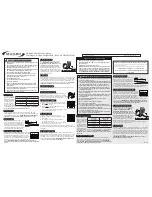
ancorproducts.com | 800.307.6702
8
OPERATOR'S MANUAL:
120V TWO SETTING HEAT GUN
1) Move the work piece outdoors. If this is not possible, open windows and place
an exhaust fan in a window. Be sure the fan is moving air from inside to outside.
Proper ventilation reduces the risk of inhaling fumes or dust created by using the
heat gun.
2) Remove or cover any household items in the area such as carpets, rugs, furniture,
clothing, cooking utensils and air ducts.
3) Place drop cloths in the work area to catch any paint chips or peelings. Wear
protective clothing such as extra work shirts, overalls and hats.
4) Wear a dust respirator mask or a dual filter (dust and fume) respirator mask, which
has been approved by the Occupational Safety and Health Administration (OSHA),
the National Institute of Safety and Health (NIOSH), or the United States Bureau of
Mines. These masks and replaceable filters are readily available at major hardware
stores. Be sure the mask fits. Beards and facial hair may keep masks from sealing
properly. Change filters often. DISPOSABLE PAPER MASKS ARE NOT ADEQUATE.
5) Work one room at a time. Furnishings should be removed or placed in the center
of the room and covered. Work areas should be sealed off from the rest of the
dwelling by sealing doorways with drop cloths.
6) Keep the work environment clean. Keep food and drinks away from the work area.
Wash hands, arms, face and rinse mouth before eating and drinking. Do not smoke,
or chew gum or tobacco in the work area. Paint scrapings and dust created from
removing paint may contain chemicals that are hazardous.
7) Children, pregnant or potentially pregnant women and nursing mothers should not
be present in the work area until the work is done and all cleanup is complete.
8) Use caution when operating the heat gun. Keep the heat gun moving to prevent
creating excessively high temperatures. Excessive heat can cause paint and other
materials to burn and cause fumes, which may be inhaled by the operator.
9) Clean up all removed paint and dust by wet mopping the floors. Use a wet cloth
to clean all walls, sills and any other surface where paint scrapings or dust have
accumulated. DO NOT SWEEP, DRY DUST OR VACUUM. Use a high phosphate
detergent, trisodium phosphate (TSP), or a trisodium phosphate substitute to clean
and mop the work area.
10) Properly dispose of paint scrapings. Following each work session put the paint
chips, scrapings, and debris in a double plastic bag. Close it with tape or twist ties
and dispose of properly.
11) Remove protective clothing and work shoes in the work area to avoid transferring
dust to other parts of the building. Wash work clothes separately. Wipe shoes
off with a wet rag that is then washed with the work clothes. Wash hair and body
thoroughly with soap and water.






























